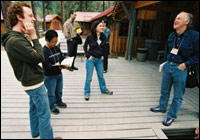On the final day of the Planet in Focus film festival in Toronto last fall, the packed house at the Royal Cinema felt every aching step of Jon Muir’s 2,500-kilometer trek in the documentary “Alone Across Australia.” When the death of Muir’s dog made his adventure truly a solo act, he quietly sobbed and rocked his dead companion, and there wasn’t a dry eye in sight. The movie’s blend of adventure, endurance, and devotion had sparked a passionate response — a common occurrence at the continent’s growing number of green film festivals.

There aren’t many scintillating documentaries about health care or education, but give filmmakers an eccentric farmer converting his family farm to organic, a 74-year-old man pedaling his 98-year-old mother around China for a year, or an activist spending two years in a tree, and they fall all over themselves to tell the stories. Increasingly, viewers are falling all over themselves to watch those tales unfold. “All of a sudden it has become the new cool, hip thing to go and see a nature film, a nature documentary,” says Demis Foster, executive director of Washington state’s Hazel Wolf Environmental Film Festival.
Hazel Wolf, currently preparing for its eighth season, is part of a North American tradition that seems to have begun in earnest in the early 1990s. That’s when Flo Stone started the D.C. Environmental Film Festival, hoping to present issues to a broader base of people than were typically interested in the cause. “I believe in film, and I think it really gets to people,” says Stone, who hopes the number of eco-festivals will continue to increase. “You remember these films and discussions, and it’s a wonderful process. It’s the grist!” (We didn’t tell her to say that, honest.)
Today there are at least a dozen annual environmental film festivals in Canada and the U.S., and there’s a booming international scene as well. During a time when film festivals in general have “mushroomed,” as one organizer puts it, green festivals are carving out a niche for themselves. Large or small, they are an excuse to gather disparate but sympathetic people and focus on the future, say their energetic boosters. “It’s interesting that there’s all this talk of the death of environmentalism,” says Tom Shevory, codirector of the Finger Lakes Environmental Film Festival in Ithaca, N.Y., “but there’s the birth of environmental film festivals.”
Let’s Get Reel
So what exactly is an environmental film festival? Well, it’s not necessarily full of films about saving a tree or river, or fighting a polluter. At the Finger Lakes festival, for instance, labor, human rights, women’s rights, and genocide all fall under the broad definition of environment. For Stone in D.C., the definition is equally far-ranging. And Planet in Focus takes things one step further: “The way Mark [Haslam, the festival’s founder] laid it out was that the environment consists of ‘contested terrain,’ whether it is the natural, the social, or the political,” says current director Candida Paltiel. “So we don’t feel restricted.”
Last year, PIF screened Travels by Tricycle, about a son’s devotion to his mother in the context of a trip around China. Like many of the films at these festivals, it took one or two degrees of interpretation to get to the eco-angle. But the reality, say many festival directors, is that the growth in eco-festivals is really just a reflection of a growing thirst for independent documentaries of any kind. “In the last 10 years, there have been more and more documentary festivals showcasing work that has no other outlet,” says Finger Lakes codirector Patricia Zimmermann.

Pass the organic popcorn.
Photo: iStockphoto.
Zimmermann adds that the green branding helps viewers remain optimistic despite often serious subject matter. “If you had a festival that said ‘War Film Festival’ or ‘The Bad Air Film Festival’ or ‘The Polluted and Contaminated Film Festival,’ no one would come,” she says. “When you say ‘environment,’ you’ve got hope.”
Given their international flavor and increasingly broad definition of “environment,” these festivals attract more than the requisite goatee-and-sandal crowd. “I don’t think you can generalize who the audience is,” Zimmermann says. “It is film by film, event by event.” Kathy Dotson, director of the Wild and Scenic Environmental Film Festival in Nevada City, Calif., says that event is put on “for activists by activists,” but agrees that the phenomenon can spread beyond the converted. “There’s always the choir in attendance,” she says, “but at the same time I think that film festivals bridge the gap.”
Audience sizes are as varied as the films that are screened. Over the next 10 days, organizers of the rechristened Environmental Film Festival in the Nation’s Capital are expecting more than 16,000 attendees to see more than 100 films, put on by 60 different organizations across the city. Next week, Hazel Wolf organizers expect 250 to 300 viewers to see about 50 films over four days at Sleeping Lady Retreat in remote Leavenworth, Wash.
There’s not much money to be made in this arena — most of the D.C. events are free, and Hazel Wolf is a nonprofit that charges small fees to cover its costs in the cause of “spreading the word.” Most festivals either barely scrape by or are heavily sponsored. “Public funds are scarce, and private funds are hard to get,” says Paltiel. “You know, we are in a very competitive market.” In fact, this year Planet in Focus is shifting its dates from late September to early November to avoid competing with Canada’s prominent Toronto International Film Festival.
But some do realize a profit. Wild and Scenic, for example, is the largest fund-raiser of the year for its organizers, the South Yuba River Citizens League. This year, they sold 4,000 tickets for 60 speakers and 80 films, raising nearly $50,000. With that kind of money flowing into Nevada City during the normally slow month of January, the event has become an important one for the entire community.
Films, Shmilms — Let’s Party
At the opening night party for Planet in Focus, after a showing of The Real Dirt on Farmer John, organic farmer John Peterson wandered a Toronto bar in his work clothes and trademark feather boa. As he worked the crowd, he pinned “I ‘Heart’ Farmer John” buttons on anyone who would let him. This in-person theater of promotion added to an already exuberant post-film fete full of students, eco-warriors, and movie lovers. Sure, in some sense it was just an excuse to party — but like writers and artists, environmentalists often toil in isolation, or at least in splintered factions. Film festivals, it turns out, may be incubating a new grassroots network.

Filmfest or schmoozefest? Both,
actually.
Photo: Hazelfilm.org
“It seems that audiences are craving this type of event,” says Dotson, and experience shows they’re not just coming for the films. Most festivals sponsor related events including speakers, live music, youth programs, eco-fairs, roundtables, and workshops. And then there are the parties. Tell a bunch of greens about a rocking gala with organic cocktail weenies and local house wine, and they’ll show up in droves. At last year’s Finger Lakes Festival, Zimmermann says, the biggest event was the gala opening, which drew 500 people. The biggest film screening, by contrast, attracted 200. (“The only reason people stayed is because we had a lot of students, and Woody Harrelson was smoking pot [in the film Go Further],” she notes.)
“People want to be in spaces chatting up ideas with other people who are suppressed or repressed in their societies,” Zimmermann says. “Nothing happens if people are alone at their computers or on their cell phones. Things happen when people are face to face and talking. In that way, it isn’t new technology, it’s old.”
Hazel Wolf’s Foster agrees that the notion of community is endangered and that film festivals can help remedy that disconnect. “Film is definitely a way to bring people together and give them a chance to see one another and connect on issues that they care about,” she says. “Environmental groups have been doing things the same way since the ’70s, in my opinion. I feel the real power to environmental campaigns comes from showing people moving images, so they can connect to the issues.”
In the end, no matter the size or the splashiness, these festivals go beyond entertainment. At a time when the movement is suffering doubt and indecision, art may be the thing that will turn people into activists. As Dotson puts it, she leaves audiences with one question: “You’ve seen the film — now what are you going to do about it?”
Coming Soon to a Screen Near You
Environmental Film Festival in the Nation’s Capital, March 16-26, Washington, D.C.
Hazel Wolf Environmental Film Festival, March 23-26, Leavenworth, Wash.
Finger Lakes Environmental Film Festival, March 30-April 6, Ithaca, N.Y.
EarthDance: The Short-Attention-Span Environmental Film Festival, April 7, Oakland, Calif.
International Wildlife Film Festival, May 13-20, Missoula, Mont.
Mountainfilm in Telluride, May 26-29, Telluride, Colo.
EarthVision International Environmental Film & Video Festival, Fall 2006 (exact dates TBA), Santa Cruz, Calif.
Banff Mountain Film Festival, Oct. 28-Nov. 5 (last year’s lineup is currently touring)
Planet in Focus International Environmental Film & Video Festival, Nov. 1-5, Toronto, Ontario
Global Visions Film Festival, Nov. 2-6, Edmonton, Alberta
Williamstown Mountain Film Festival, Nov. 4-5, Williamstown, Mass.2007
Wild and Scenic Environmental Film Festival, Jan. 12-14, Nevada City, Calif.
Big Sky Documentary Film Festival, Feb. 15-21, Missoula, Mont.
Siskiyou Environmental Film Festival, February (exact dates TBA), Ashland, Ore.
Jackson Hole Wildlife Film Festival, dates TBA, Jackson Hole, Wyo.
Eckerd College Environmental Film Festival, dates TBA, St. Petersburg, Fla.To discuss this story or post other environmental film events, check out our blog.

